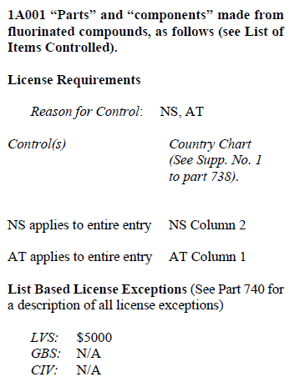 Does my product require an export license? That’s a question you should ask before every export.
Does my product require an export license? That’s a question you should ask before every export.
To find the answer, you first need to answer two preliminary questions:
- What is the Export Control Classification Number (ECCN) of the product?
- What is the destination country?
The ECCN codes are found in the Commerce Control List (CCL), which is part of the Department of Commerce’s Export Administration Regulations (EAR). Picking the right ECCN requires that you understand the technical characteristics of the product you’re shipping. This process is outlined in my previous article, Learning the Essentials of U.S. Export Controls.
You can spend hours manually paging through the Commerce Control List to find the ECCNs of your products, or you could use a tool like the Shipping Solutions Product Classification Wizard to make your search process both more efficient and more thorough.
(Different government agencies have jurisdiction over different types of exports. This article is only concerned with exports that fall under the jurisdiction of the Commerce Department, the agency that controls most U.S. exports. For more information about State Department regulations, read Understanding ITAR: The International Traffic in Arms Regulations.)
 Reasons for Control
Reasons for Control
Each ECCN has associated ECCN reasons for control. These are reasons why the export of this product would be controlled; in other words, reasons this product might require an export license.
Along with the ECCN reasons for control, there are also country reasons for control. These are reasons why exports to that particular country are controlled; in other words, reasons why exports to that particular country would need an export license.
Once you know the ECCN and the destination country, you have two options for determining whether your product needs an export license: (1) look at the printed Commerce Country Chart, or (2) use software to speed up the process.

Using the Commerce Country Chart
The old-school way of determining if you need a license for your export involves lining up rows with columns on the Commerce Country Chart to see if there are any reasons for control that show up in both the ECCN reasons and the country reasons.
If there is a reason that is listed under both the ECCN reasons and the country reasons, then the export shipment is controlled, meaning it requires the exporting company to apply for a license or otherwise obtain authorization from the controlling agency.
I outline this more manual process in my previous article, Using the Commerce Country Chart to Determine if You Need an Export License.
Using Export Software
Shipping Solutions Professional export documentation software features an Export Compliance Module, which includes an Export License Determination tool. At the click of a button, this tool automatically screens your products and the country of destination against the EAR, making for a more efficient and thorough screening process that manually checking the Commerce Country Chart simply can’t match.
License Exceptions
Just as there are both ECCN reasons for control and country reasons for control, there are ECCN license exceptions and country license exceptions. License exceptions refer to specific criteria that, if met, allow a company to export without a license even when there are one or more reasons for control.
On top of detailing the reasons for control, Shipping Solutions Professional’s Export License Determination tool also provides information on any license exceptions that may be available for your exports. See our article A Beginner’s Guide to Export License Exceptions for an overview.
Other Considerations
Four factors play a role in determining if you need an export license. In this article, we’ve covered two:
- The technical characteristics of the product (as communicated in the form of an ECCN; and
- The destination country.
Two other factors are important not to overlook:
- The end user (the identity of the party to whom the shipment will ultimately be sent); and
- The end use (how the goods will actually be used).
I explain the last two factors in my article Export Compliance: The Importance of Knowing End Use and End Users.
Glossary of Acronyms
The U.S. government uses acronyms as shorthand to identify the different reasons for control and the different license exceptions. We’ve compiled a glossary for your reference below:
Reasons for Control
- AT—Anti-Terrorism
- CB—Chemical & Biological Weapons
- CC—Crime Control
- CW—Chemical Weapons Convention
- EI—Encryption Items
- FC—Firearms Convention
- MT—Missile Technology
- NS—National Security
- NP—Nuclear Nonproliferation
- RS—Regional Stability
- SS—Short Supply
- UN—United Nations Embargo
- SI—Significant Items
- SL—Surreptitious Listening
License Exceptions
- LVS—Shipments of Limited Value
- GBS—Shipments to Country Group B Countries
- CIV—Civil End-Users
- TSR—Technology and Software Under Restriction
- APP—Computers
- TMP—Temporary Imports, Exports, Re-exports, and Transfers In-Country
- RPL—Servicing and Replacement of Parts and Equipment
- GOV—Governments, International Organizations, International Inspections Under the Chemical Weapons Convention, and the International Space Station
- GFT—Gift Parcels and Humanitarian Donations
- CCD—Consumer Communications Devices
- TSU—Technology and Software Unrestricted
- BAG—Baggage
- AVS—Aircraft, Vessels, and Spacecraft
- APR—Additional Permissive Re-exports
- ENC—Encryption Commodities, Software, and Technology
- AGR—Agricultural Commodities
- STA—Strategic Trade Authorization
- SCP—Support for the Cuban People
For more information about the export license process, download our free guide: How to Determine If You Need an Export License.
Like what you read? Join thousands of exporters and importers who subscribe to Passages: The International Trade Blog. You’ll get the latest news and tips for exporters and importers delivered right to your inbox.
This article was first published in October 2018 and has been updated to include current information, links and formatting.

